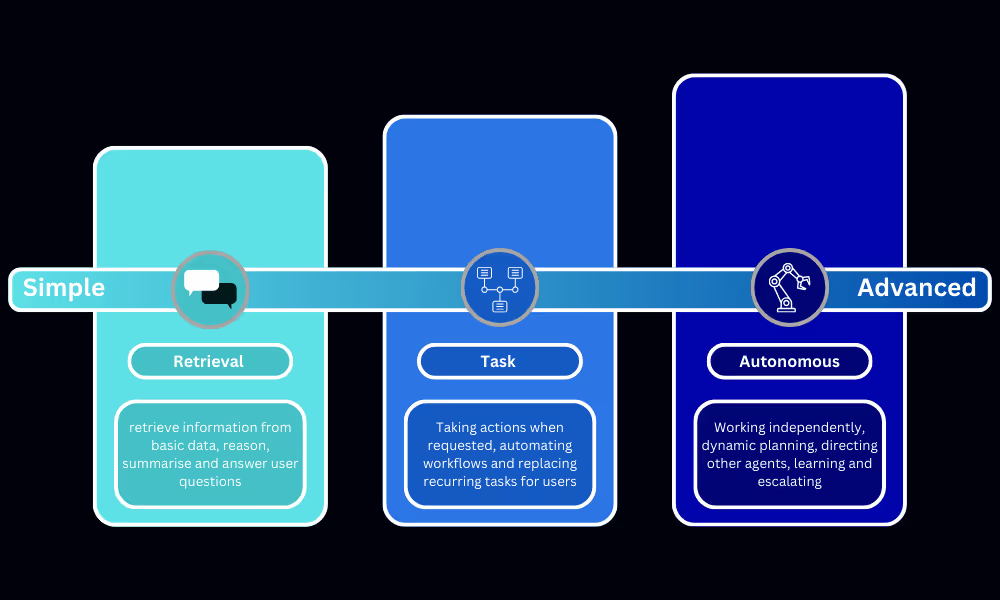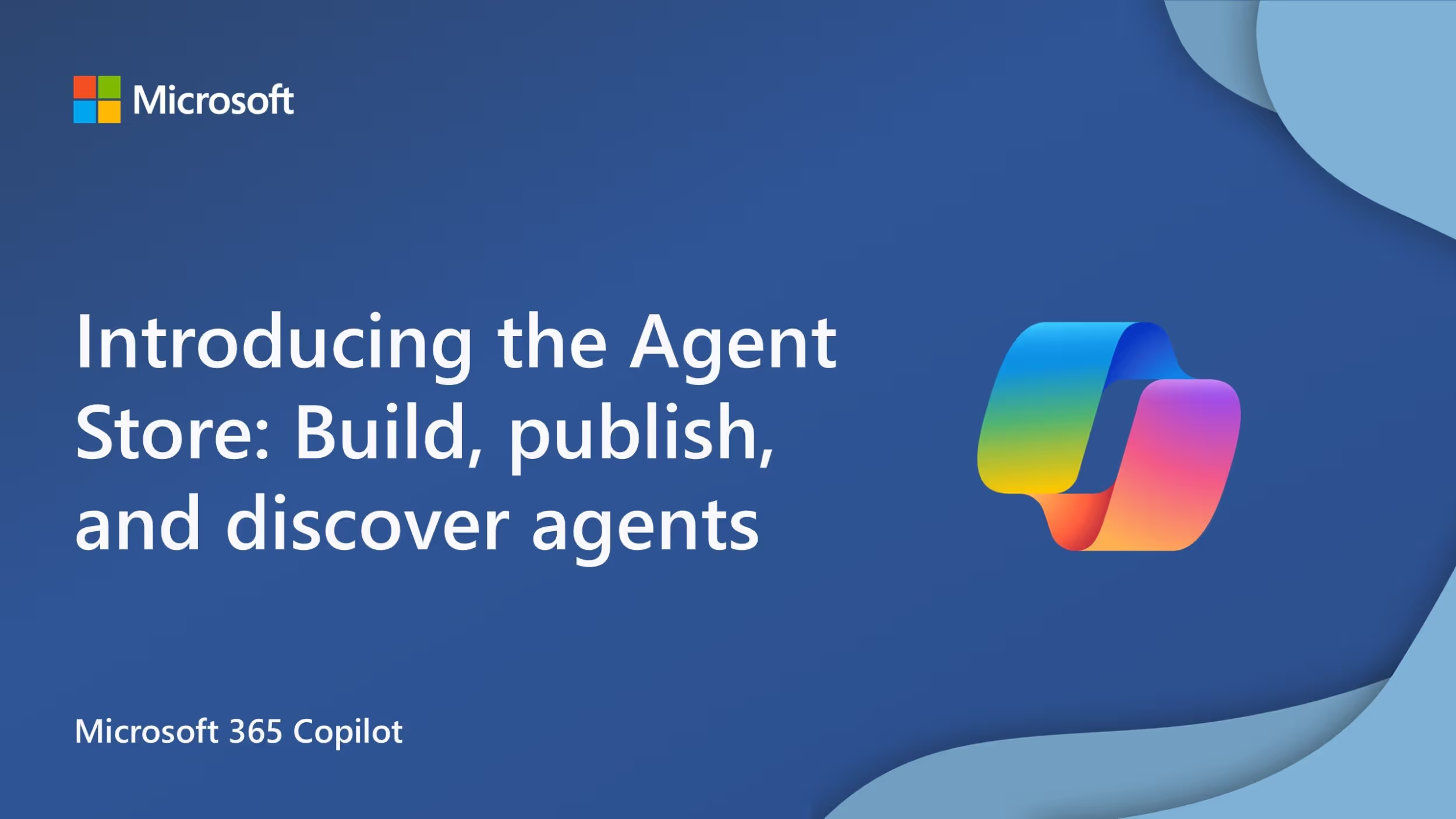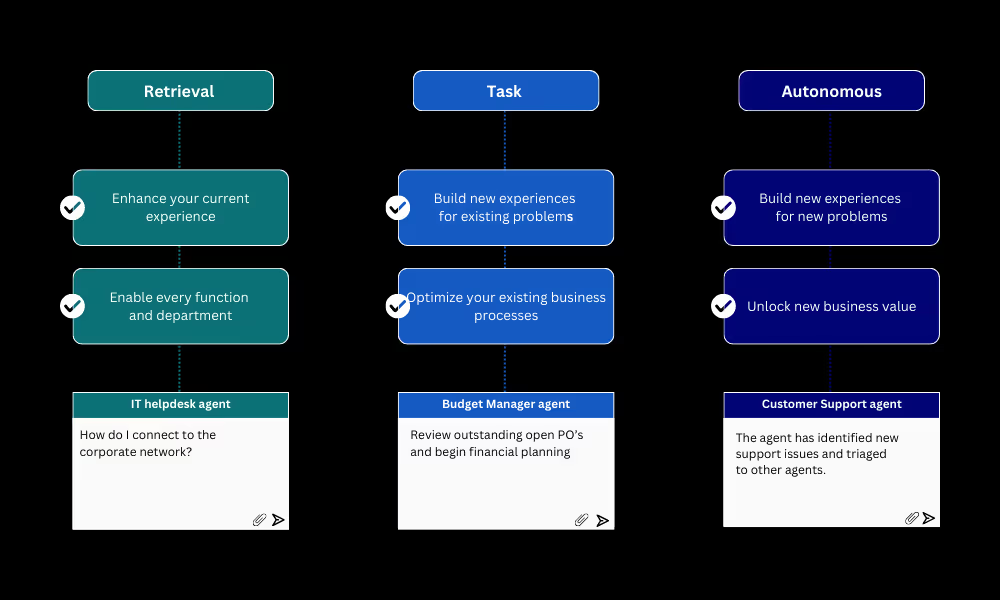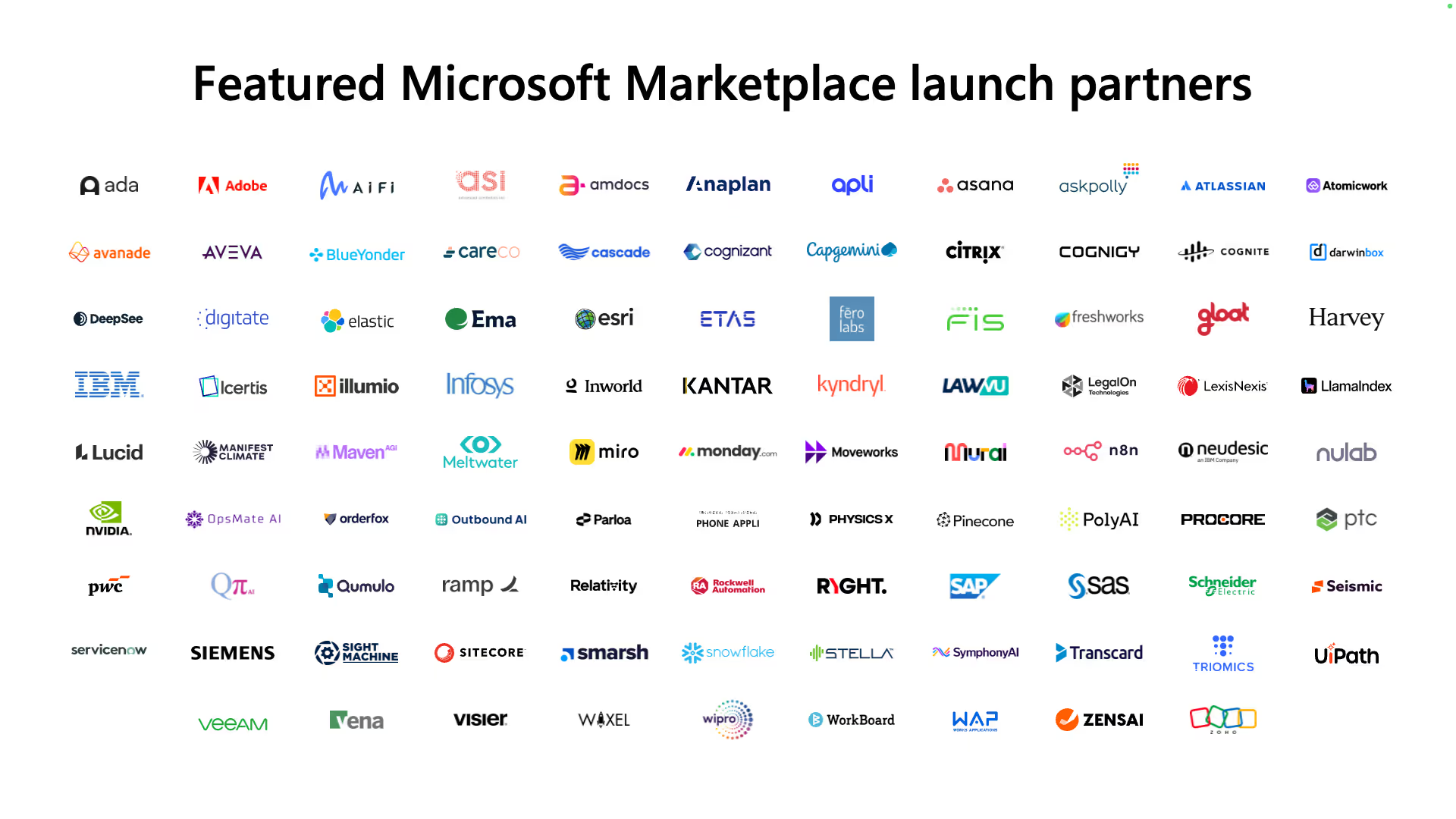
AI Agents in the Microsoft Marketplace

.avif)


.avif)
Microsoft’s recent launch of Agents in the Microsoft Marketplace signals a new era where intelligent assistants can be discovered, deployed, and even monetized with unprecedented ease. In this article, we at Digital Bricks break down what this release means, how you can take advantage of it, and why agentic solutions present exciting opportunities for both productivity and business growth.
Think of an AI agent as a smart digital assistant that can understand its environment, make decisions, and perform tasks to help individuals or organizations. These aren’t just simple chatbots answering FAQs. An AI agent can range from a basic helper that retrieves information, to a sophisticated autonomous system that analyzes data and takes action. In essence, it’s like having a team member who works tirelessly on specific tasks – from sorting your inbox to generating a market research report – all powered by artificial intelligence.

The reason AI agents are in the spotlight now comes down to need and timing. According to Microsoft’s 2025 Work Trend Index, 81% of business leaders plan to integrate AI agents into their strategy, yet only about 24% have deployed one company-wide so far. There’s clearly a huge interest in leveraging AI for everyday work, but most organizations haven’t crossed the adoption hurdle. Common roadblocks include not knowing where to start, uncertainty about which solutions can be trusted, and how to encourage employees to actually use these AI helpers in their daily workflow. Microsoft’s latest move aims to close this gap by making AI agents more accessible and trustworthy within the tools people already use.
It also helps that the technology has matured. Advances in AI (like more powerful language models and better integration capabilities) mean these agents are smarter and more reliable than ever. Analysts are even projecting that by 2028 there could be over 1.3 billion AI agents in operation worldwide – a sign that we’re at the cusp of an AI agent revolution in the workplace. In short, the convergence of business demand and technological readiness has set the stage for AI agents to become mainstream.
To kickstart this revolution, Microsoft introduced the Microsoft 365 Copilot Agent Store – an in-product storefront where users can discover and install ready-to-use AI agents right inside the flow of work. If you’re using Microsoft 365 Copilot (Microsoft’s AI-powered assistant platform integrated into apps like Teams, Outlook, Word, etc.), the Agent Store is like an app store for AI helpers that lives within those applications. This means employees can find AI agents without ever leaving their usual Microsoft 365 workspace.
The beauty of the Agent Store is how seamlessly it blends into everyday work. It provides personalized recommendations, surfacing relevant agents based on each user’s role and needs. Because it’s built into Microsoft 365, the interface feels familiar and convenient – you’re essentially getting AI enhancements in the same place you handle email, documents, and meetings. This ease of discovery and native integration is crucial for driving adoption. Employees can click and add an agent to help with a task, just as easily as they might install a new app on their phone.

What kinds of tasks can these agents handle? The Agent Store’s catalog spans solutions for many real-world business challenges. For example, there are agents to conduct comparative market research, crunch through inventory analysis, or even automate IT helpdesk requests. It’s like having a roster of specialists on call: one agent might summarize lengthy reports for you, another might integrate with your CRM to pull sales insights, and yet another could handle routine HR questions from staff. Microsoft has included some built-in agents of their own (to tackle common productivity needs), and importantly, they’ve opened the doors to a robust catalog of partner-built agents. This mix of Microsoft-built and third-party offerings means you’ll find solutions crafted by experts in various domains – whether it’s an official Microsoft helper for Outlook or a partner’s AI agent that connects to an external service like your ERP or data warehouse.

Crucially, every third-party agent in the store goes through rigorous validation for security, compliance, and performance. Microsoft knows enterprises will only embrace these tools if they trust them. So, if you see an agent in the Copilot store from a Microsoft partner, you can be confident it meets high standards and won’t compromise your data or IT governance. For IT leaders, the Agent Store also provides control mechanisms: through the admin center, organizations can manage which agents employees are allowed to install, ensuring compliance and alignment with company policy. In short, the Agent Store balances empowerment and control – giving employees helpful AI tools while letting IT keep oversight.
You might be wondering about the distinction between agents that Microsoft has built into the platform versus those coming from outside partners. In practice, they all appear side by side in the Agent Store, but there are a few differences to note:
Microsoft-Built Agents: These are developed by Microsoft and often focus on enhancing the core Microsoft 365 experience. They might handle generic productivity tasks or extend existing Microsoft features. Because they’re first-party, they typically integrate deeply with Microsoft 365 data and services out-of-the-box. Think of these as the default AI assistants that improve Office workflows (for example, an agent that helps schedule meetings or refines your Word documents). Microsoft-built agents are usually included as part of the Copilot experience for subscribers, and they benefit from Microsoft’s intimate knowledge of its own ecosystem.
Partner-Built Agents: These come from Microsoft’s ecosystem of trusted partners – independent software vendors, SaaS companies, and even startups. Partner agents tend to bring in specialized capabilities or connect with external systems and industry-specific solutions. For instance, you’ll find agents from companies like Snowflake (for data analytics in natural language), Asana (to turn chat conversations into project tasks), LexisNexis (legal research assistant), Meltwater (media and data insights), SAP (business process assistant), ServiceNow (IT service management in chat), and many more. These agents leverage the partner’s expertise and often integrate Microsoft 365 Copilot with the partner’s own platform or data. They might require a subscription or purchase (since they are monetized products), but they vastly extend what Copilot can do by adding new “skills” to your AI toolkit.

Functionally, both Microsoft and partner agents are installed and used in a similar way by end users – you can converse with them or command them through the Copilot interface. The key differences boil down to who developed them and their scope of functionality. Microsoft’s agents aim to improve general productivity within the Microsoft stack, whereas partner agents can connect beyond, solving niche problems or connecting to third-party services. Another difference is support and updates: partner agents will be maintained by the provider who built them, often with frequent improvements especially if that agent ties into the provider’s latest features. Microsoft agents will evolve alongside the Copilot platform itself.
From a user’s perspective, the variety of partner agents is a huge win. It means you’re not limited to Microsoft’s ideas of what an AI assistant should do. The marketplace approach creates healthy competition and innovation – dozens of companies are now building specialized agents, so there’s likely one that fits your unique use case. And as mentioned, Microsoft ensures even these third-party agents meet enterprise security and compliance benchmarks. So whether an agent’s badge says Microsoft or a partner name, you can deploy it with confidence if it’s in the store.
One of the biggest announcements accompanying the agent launch is the new Microsoft Marketplace – a one-stop web portal where customers can find, try, and buy not just AI agents, but all kinds of cloud solutions and apps. Microsoft essentially unified its earlier app stores (AppSource and Azure Marketplace) into a single Marketplace, and added a dedicated category for “AI Apps and Agents.” This is a significant change that reflects how central AI has become in software.
For business users and leaders, the unified marketplace offers a connected experience. You can browse the entire catalog of agents (including the same ones you see in the Copilot Agent Store) from your web browser, reading detailed descriptions, pricing, and reviews. It’s all one catalog whether you’re looking inside a Microsoft app or on the web. This unified approach ensures consistency – the listing you see online is exactly what you get when deploying in Microsoft 365, and any purchase or license carries over seamlessly. In practice, a company might research an AI agent on the Marketplace site (perhaps an operations manager searching for “inventory management AI agent” finds a solution), and then with a few clicks, they can procure it and deploy it to their employees via the Copilot Agent Store. The heavy lifting of provisioning and integration is handled by Microsoft’s infrastructure. The result is that adopting a new AI tool can be as simple as installing a Teams app.
From Microsoft’s perspective, bringing everything under one marketplace amplifies reach. They reported that millions of users visit the Marketplace every month, and with over 3,000 AI apps and agents available at launch in this category, customers have a vast selection. Unifying the storefront also benefits partners (and customers) by simplifying the buying journey. There’s a single place to go, and a familiar checkout process using Microsoft’s global commerce platform. For companies that have enterprise agreements or Azure consumption commitments, buying through the Marketplace can even be bundled into those agreements – which makes procurement of third-party solutions easier to justify and budget.
In short, the Microsoft Marketplace’s evolution means discoverability and scale. AI solutions from partners become more visible to potential customers, and customers get an Amazon-like experience of shopping for AI capabilities knowing that everything listed plays nicely with their Microsoft environment. This is a virtuous cycle: better visibility drives more partner innovation, which in turn offers customers more choices to turbocharge their workflows with AI.
What if the out-of-the-box agents don’t cover a specific need you have? Or perhaps your company has a brilliant idea for an AI agent that others could use too? Microsoft has anticipated this, providing pathways for both internal development and public publishing of AI agents.

For organizations wanting to build custom agents for internal use: Microsoft 365 Copilot comes with a Copilot Studio – a toolkit that allows developers (or technically inclined power users) to create and fine-tune AI agents. Using Copilot Studio, you can define an agent’s skills, feed it proprietary knowledge (like your company’s internal data or policies), and design how it interacts with users. Once built, you can deploy these agents within your organization through the Agent Store, even limiting access to specific departments if needed. This means large companies can craft AI assistants tailored to their internal processes – think of a company-specific Copilot that knows your business lingo and workflows. All of this can be done while keeping the agent private to your tenant, so your competitive intelligence stays in-house.
For partners or developers who want to sell an AI agent publicly: Microsoft has opened the Marketplace for you too! In order to publish an AI agent as an offering on the Marketplace, there’s a clear (and fairly streamlined) process through Microsoft’s Partner Center. Here’s a high-level overview of how to publish an AI agent in the Microsoft Marketplace:
First, develop your AI agent. Depending on the scenario, you might build it to run on Azure (for example, a web service powered by AI that your customers access) or as an integrated Microsoft 365 Copilot add-in (for example, an agent that plugs into Teams or Outlook). Microsoft categorizes agents broadly into “Azure agents” and “Microsoft 365 Copilot agents.” Azure agents are general-purpose AI solutions that run in the cloud (either hosted by you as a SaaS or deployable in a customer’s environment via containers). Microsoft 365 agents, on the other hand, live inside Office apps and Copilot experiences. Choosing the right type is important as it defines how customers will use and deploy your agent.
To list anything on the Marketplace, you need to be a part of the Microsoft AI Cloud Partner Program. Additionally, for AI agents there are specific programs to enroll in. For Microsoft 365 Copilot integrations, you join the Microsoft 365 & Copilot publisher program, and for Azure-based solutions you might also join the general Commercial Marketplace program. This sounds like a lot, but essentially it’s Microsoft making sure partners meet certain criteria and can transact properly. Once you’re enrolled, you get access to the publishing tools and resources.
This is where you describe your agent for prospective customers. You’ll provide an offer name, a detailed description of what your AI agent does, and how it helps businesses. You also choose categories (make sure to tag it under the AI Apps and Agents category for maximum visibility!). Microsoft has guidance on crafting a compelling listing – it’s akin to writing a product page that convinces people to try your solution. You can include screenshots or even demo videos. A good listing speaks to the business problem you solve, and any unique AI capabilities your agent has.
One big opportunity in publishing an agent is the ability to monetize your AI solution. Microsoft’s marketplace supports various pricing models to fit your business. For a cloud-based agent, you might charge per user or a flat monthly fee for access (entitlement model), or charge based on usage (for instance, number of documents processed or queries made). For agents that customers deploy in their own cloud (like a containerized solution), you could price based on the resources used (cores, transactions, etc.). And if you’re listing a Microsoft 365 Copilot agent, you have the option to link it to a SaaS subscription – meaning, for example, a customer installs your Copilot add-in but needs an active subscription on your service to use it fully. The Marketplace will handle the billing and transactions in all these cases, simplifying sales for you. It’s worth noting you can also offer free trials or even free basic tiers to encourage adoption.
After filling in all the details and pricing, you submit your agent offer to Microsoft for review. They will validate that your agent meets the technical and policy requirements (for security, functionality, etc.). This is the “app store review” process but for AI agents. Once approved, your agent listing goes live on the Marketplace and becomes discoverable to Microsoft’s enormous customer base. It will also appear in the in-product Agent Store for Microsoft 365 users, if it’s a Copilot-integrated agent. Now you’ve officially hung up your shingle in the AI marketplace!

From here, Microsoft helps with the heavy lifting: they handle billing in multiple currencies, provide analytics on your listing’s performance, and even allow your solution to be resold by Microsoft’s global channel partners (a huge plus if you want to scale). As a publisher, you can focus on improving your AI agent and supporting your customers, rather than worrying about payment systems or international reach.
For forward-thinking companies and software providers, the rise of AI agents in the Microsoft Marketplace isn’t just a tech trend – it’s a business opportunity. Monetizing agentic solutions means you can create real value (and revenue) by packaging your expertise into an AI agent.
Take a company that specializes in financial analytics. In the past, they might sell reports or consultancy hours. Now, they could encapsulate some of that know-how into an AI agent that automatically analyzes a client’s financial data and gives recommendations in plain English. By publishing this as an agent on the Marketplace, they suddenly have a product that dozens or hundreds of businesses might subscribe to. Microsoft’s infrastructure handles the sales and distribution globally, so a small firm’s innovation can reach Fortune 500 companies worldwide if it’s compelling enough.
The Marketplace’s support for flexible pricing models means you can align the monetization with the value your agent provides. If your agent saves hours of work, a per-user subscription might make sense. If it performs heavy computations, maybe usage-based pricing works. Microsoft even allows custom meters (for example, charging per transaction or per API call) through its commerce platform. Importantly, because many enterprises prefer buying through an established marketplace (to simplify vendor management and compliance), listing your agent there can shorten the sales cycle. Companies can buy your AI solution just like they purchase Azure services or Microsoft licenses, often drawing from pre-approved budgets.
Another key opportunity is co-sell and partnerships. Microsoft is actively encouraging partners to build these agents, and they often engage in co-selling, where Microsoft’s own sales teams help bring partner solutions into customer deals (especially when those solutions drive Azure usage or add value to Microsoft’s platform). As an agent publisher, this means you’re not alone – you have a tech giant potentially cheering on your solution because it enhances their ecosystem’s appeal.
There’s also the angle of channel sales: Microsoft Marketplace now allows partners to authorize resellers and distributors to sell their marketplace offerings. In plain terms, if you build a great AI agent, large distributor companies (the kind who serve thousands of local IT providers) could include your agent in their catalog, bundled with other services. This extends your reach even further into new markets and industries. The Marketplace essentially acts as a multiplier for your sales efforts.
All of this boils down to a simple but profound shift: AI is becoming a product. We’re moving beyond just consuming pre-made AI features, to a model where organizations can package and sell AI capabilities much like software. If you have deep expertise in a domain (be it healthcare, law, supply chain, customer service, you name it), creating an AI agent that leverages that expertise can open a new revenue stream. And thanks to Microsoft, you have a ready-made platform to sell it, with an audience already in the millions.
If you’re a business leader or an IT decision-maker, the advent of AI agents in Microsoft’s ecosystem should be on your radar because it represents a tangible way to boost productivity and innovation in your organization. Here are a few key implications and takeaways:
At Digital Bricks, we view the rise of AI agents in the Microsoft Marketplace as a pivotal moment in digital transformation. It’s not just another software update; it’s the beginning of a new way of working. We’ve long believed that context-aware, intelligent assistants can fundamentally reshape how work gets done, and now we’re seeing that vision take a very concrete form through Microsoft 365 Copilot and its ecosystem of agents.
From our perspective, the organizations that will thrive in this agentic future are those that take a proactive approach. This means leaders should start thinking about which repetitive processes or knowledge bottlenecks in their business could be handed off to AI agents. It also means considering how to architect your workflows to integrate AI smoothly – for example, ensuring your data is in order so that an AI agent can access up-to-date, relevant information when assisting your team.
There is also a strategic element: As AI agents become common, having a strategy for them will be as important as your cloud or mobile strategy was a decade ago. This is where partnering with an agentic AI consultancy can be invaluable. Navigating this space might feel overwhelming – with questions like “Should we buy an existing agent or build our own?”, “How do we ensure the agent’s answers align with our company’s policies and tone?”, or “What’s the ROI on deploying an AI agent for a particular task?”. Experienced consultants who specialize in AI (like our team at Digital Bricks) can guide you through these questions. We help organizations identify high-impact use cases for AI agents, choose the right tools or frameworks, and even assist in developing custom agents when the off-the-shelf options don’t fit perfectly. The goal is to ensure that adopting AI agents actually delivers value and integrates smoothly with your people and processes.
One thing we emphasize is human-centric design when deploying AI. An AI agent should empower your employees, not frustrate them. So it’s crucial to involve your teams in the rollout – get feedback, start with pilot users, and iterate. Change management (training, setting expectations, clarifying what the agent can and cannot do) will make a big difference in how well the new AI colleague is received. From what we’ve seen, when implemented thoughtfully, even skeptical employees quickly learn to appreciate an agent that saves them from drudgery (imagine a salesperson who initially doubted an AI, but after a month sees that the AI draft responses to emails frees up an hour each day to spend with clients – they become a fan pretty fast).
As we stand on this exciting frontier, it’s worth remembering that we’re in the early days of a long journey. The Microsoft Marketplace and Copilot agents available today are incredibly powerful, but they will continue to evolve. The agents will get smarter, more specialized, and more numerous. Businesses that start experimenting now will be better positioned to leap ahead as capabilities grow. Just as mobile apps transformed business in the 2010s, AI agents could define the late 2020s in terms of productivity and innovation.